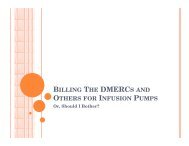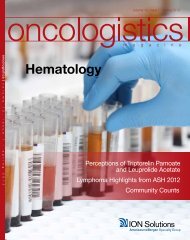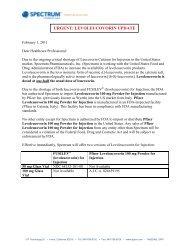Single Vial Docetaxel Injection - ION Solutions
Single Vial Docetaxel Injection - ION Solutions
Single Vial Docetaxel Injection - ION Solutions
Create successful ePaper yourself
Turn your PDF publications into a flip-book with our unique Google optimized e-Paper software.
In vivo studies showed that the exposure of docetaxel increased 2.2-fold when it was<br />
coadministered with ketoconazole, a potent inhibitor of CYP3A4. Protease inhibitors, particularly<br />
ritonavir, may increase the exposure of docetaxel. Concomitant use of <strong>Docetaxel</strong> <strong>Injection</strong> and drugs that<br />
inhibit CYP3A4 may increase exposure to docetaxel and should be avoided. In patients receiving<br />
treatment with <strong>Docetaxel</strong> <strong>Injection</strong>, close monitoring for toxicity and a <strong>Docetaxel</strong> <strong>Injection</strong> dose reduction<br />
could be considered if systemic administration of a potent CYP3A4 inhibitor cannot be avoided [see<br />
Dosage and Administration (2.7) and Clinical Pharmacology (12.3)].<br />
8 USE IN SPECIFIC POPULAT<strong>ION</strong>S<br />
8.1 Pregnancy<br />
Pregnancy Category D [See 'Warnings and Precautions' section]<br />
Based on its mechanism of action and findings in animals, <strong>Docetaxel</strong> <strong>Injection</strong> can cause fetal<br />
harm when administered to a pregnant woman. If <strong>Docetaxel</strong> <strong>Injection</strong> is used during pregnancy, or if the<br />
patient becomes pregnant while receiving this drug, the patient should be apprised of the potential hazard<br />
to the fetus. Women of childbearing potential should be advised to avoid becoming pregnant during<br />
therapy with <strong>Docetaxel</strong> <strong>Injection</strong>.<br />
<strong>Docetaxel</strong> <strong>Injection</strong> can cause fetal harm when administered to a pregnant woman. Studies in both<br />
rats and rabbits at doses ≥0.3 and 0.03 mg/kg/day, respectively (about 1/50 and 1/300 the daily maximum<br />
recommended human dose on a mg/m 2 basis), administered during the period of organogenesis, have<br />
shown that docetaxel is embryotoxic and fetotoxic (characterized by intrauterine mortality, increased<br />
resorption, reduced fetal weight, and fetal ossification delay). The doses indicated above also caused<br />
maternal toxicity.<br />
8.3 Nursing Mothers<br />
It is not known whether docetaxel is excreted in human milk. Because many drugs are excreted in<br />
human milk, and because of the potential for serious adverse reactions in nursing infants from <strong>Docetaxel</strong><br />
<strong>Injection</strong>, a decision should be made whether to discontinue nursing or to discontinue the drug, taking into<br />
account the importance of the drug to the mother.<br />
8.4 Pediatric Use<br />
The safety and effectiveness of docetaxel in pediatric patients have not been established.<br />
8.5 Geriatric Use<br />
In general, dose selection for an elderly patient should be cautious, reflecting the greater frequency<br />
of decreased hepatic, renal, or cardiac function and of concomitant disease or other drug therapy in elderly<br />
patients.<br />
Non-Small Cell Lung Cancer<br />
In a study conducted in chemotherapy-naïve patients with NSCLC (TAX326), 148 patients (36%)<br />
in the docetaxel+cisplatin group were 65 years of age or greater. There were 128 patients (32%) in the<br />
vinorelbine+cisplatin group 65 years of age or greater. In the docetaxel+cisplatin group, patients less than<br />
65 years of age had a median survival of 10.3 months (95% CI: 9.1 months, 11.8 months) and patients 65<br />
Page 27 of 46














